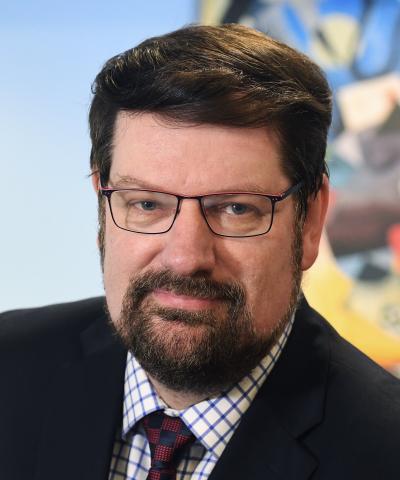Andreas H. Hielscher, Ph.D.
Professor and Chair
Dept. Biomedical Engineering
Director, Clinical Biophotonics Laboratory (CBL)
New York University
Tandon School of Engineering
Seminar Information

Deep tissue optical tomographic imaging (DOTI) seeks to obtain functional information about tissues to assist in the diagnosis, monitoring, and treatment of various diseases. In this emerging imaging modality, near-infrared light is employed to illuminate the body part under investigation and transmitted and reflected light intensities are measured. So-called model-based iterative image reconstruction algorithms are then used to convert this information into 3-dimensional tomographic concentration maps of oxy-hemoglobin (HbO2), deoxy-hemoglobin (Hb), and total hemoglobin (THb). Furthermore, other physiologically important parameters such as oxygen saturation (StO2), water content, tissue scattering, etc. can be obtained. Over the last decade, considerable progress has been made towards clinically viable DOTI systems that assess brain function, cancer (e.g. breast, prostate, and skin), peripheral artery disease, and joint diseases. In addition to providing insights on hardware design and image reconstruction software, the presentation will focus on recent results obtain in clinical studies involving breast cancer, peripheral artery disease in diabetics, and lupus arthritis. Moreover, most recent advance in making DOTI a wearable technology will be described. Novel flexible electronics allow the integration of related hardware into fabrics, which provides for a more user-friendly interface and in-home monitoring capabilities.
(For more information have a look at https://wp.nyu.edu/tandonschoolofengineering-cbl/)
Professor Andreas H. Hielscher received his PhD degree in Electrical and Computer Engineering from Rice University, Houston, Texas. After a postdoctoral fellowship at the Los Alamos National Laboratory in New Mexico, he joined the faculty at the SUNY Downstate Medical Center. In 2001 he accepted an offer from Columbia University in New York City, where he became the Director of the Biophotonics and Optical Radiology Laboratory. He held appointments as Professor in the Departments of Biomedical Engineering, Electrical Engineering and Radiology. In summer 2020, he moved across town to assume the chair position of the newly formed Department of Biomedical Engineering at New York University (NYU). His work focuses on the development of state-of-the-art systems for optical tomography. He applies this technology to diagnose and monitor arthritis, vascular diseases, and breast cancer. More recently he embarked on the implementation of an optical brain-machine interface. He has published over 300 scientific articles, several book chapters, and holds over 20 patents. His work has been funded by various institutes at National Institutes of Health (NIAMS, NIBIB, and NCI), DARPA, and other national and international funding agencies. Since 2013, he has been a Fellow of the American Institute for Medical and Biological Engineering (AIMBE).
